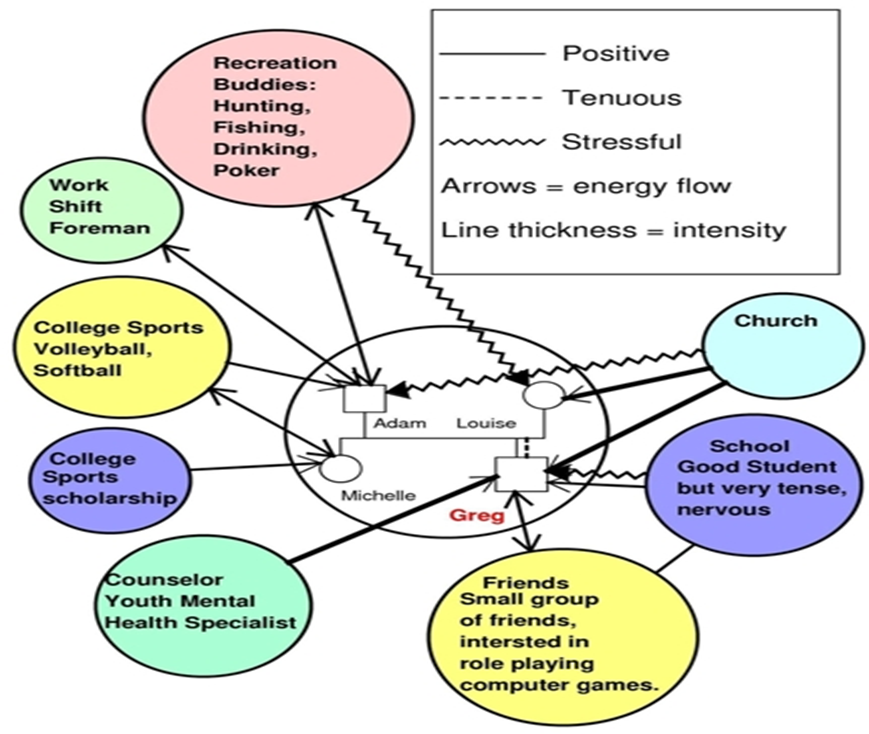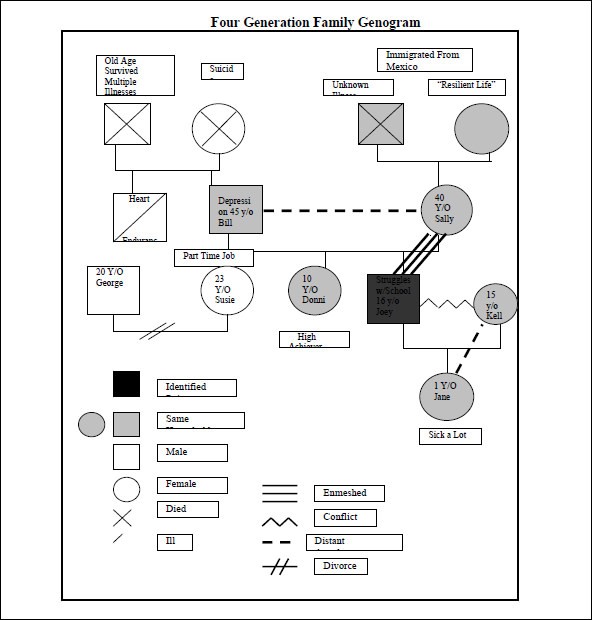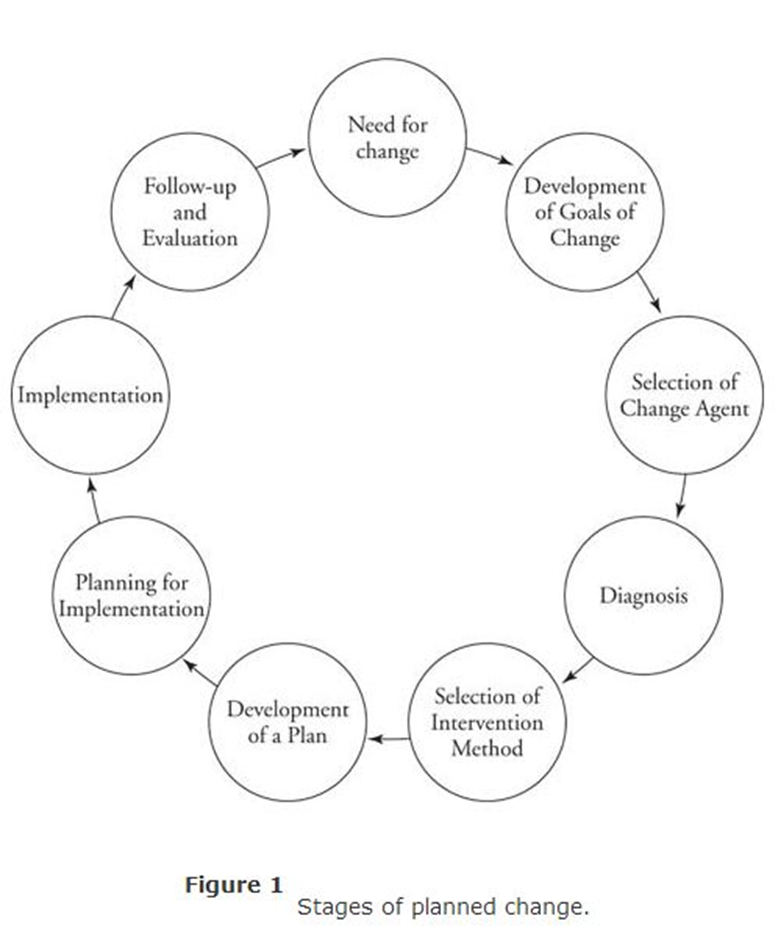1.4: Generalist Practice
- Last updated
- Save as PDF
- Page ID
- 24546

- Aikia Fricke
- Ferris State University
When looking at generalist practice primary theories, the first question that may come to mind is what is generalist practice? Generalist practice introduces students to the basic concepts in social work which includes promoting human well-being and applying preventative and intervention methods to social problems at individual (micro), group (mezzo), and community (macro) levels while following ethical principles and critical thinking (Inderbitzen, 2014).
Now that you have some insight on what generalist practice is, we should discuss what a social work generalist does. A social work generalist uses a wide range of prevention and intervention methods when working with families, groups, individuals, and communities to promote human and social well-being (Johnson & Yanca, 2010).
Being a social work generalist practitioner prepares you to enter nearly any profession within the social work field, depending on your population of interest (Inderbitzen, 2014).
Micro, Mezzo, Macro Levels of Social Work
Micro level social work is the most common practice scenario and happens directly with an individual client or family; in most cases this is considered to be case management and therapy service. Micro social work involves meeting with individuals, families or small groups to help identify, and manage emotional, social, financial, or mental challenges, such as helping individuals to find appropriate housing, health care, and social services. Micro-practice may even include military social work like helping military officials and families cope with military life and circumstances (see Chapter 14), school social work which could involve helping with school related resources, Individual education plans, and so on (see Chapter 11), or a mental health case manager to help individuals understand and cope with their mental illnesses (see Chapter 10).
The focus of micro level practice is to help individuals, families, and small groups by giving one on one support and provide skills to help manage challenges (Johnson & Yanca. 2010).
Mezzo level social work involves developing and implementing plans for communities such as neighborhoods, churches, and schools. Social workers on the mezzo level interact directly with people and agencies that share the same passion or interest. The big difference between micro and mezzo level social work is that instead of engaging in individual counseling and support, mezzo social workers administer help to groups of people. Examples of work and interest that mezzo social workers could be involved in include the establishment of a free food pantry within a local church to help with food resources for vulnerable populations, health clinics to provide services for the uninsured, or community budgeting/financial programs for low income families.
Many mezzo social work roles exist; however social workers generally engage in micro and mezzo practice simultaneously (Kirst-Ashman & Hull, 2015).
Macro level social work is very distinct from micro and mezzo level. The focus of macro level social work is to help vulnerable populations indirectly and on a larger scale. The responsibilities for social workers on a macro level typically are finding the root cause or the why and effects of citywide, state, and/or national social problems.
They are responsible for creation and implementation of human service programs to address large scale social problems. Macro level social workers often advocate to encourage state and federal governments to change policies to better serve vulnerable populations (Kirst-Ashman & Hull, 2015).
Social workers that work on the macro level are often employed at non-profit organizations, public defense law firms (working pro-bono cases), government departments, and human rights organizations.
While macro social workers typically do not provide therapy or other assistance (case management) to clients, they may interact directly with the individuals while conducting interviews during their research that pertains to the populations and social inequalities of their interest.
Although, social work is broad and allows practitioners to move within the micro, mezzo, and macro levels. All social workers begin at the micro level to understand the inequalities, disadvantages, and the needed advocacy for vulnerable populations.
Theories
Systems Theory
Systems Theory is an interdisciplinary study of complex systems. It focuses on the dynamics and interactions of people in their environments (Ashman, 2013). The Systems Theory is valuable to the social work profession because it assists social workers with identifying, defining, and addressing problems within social systems.
As social workers, we utilize the Systems Theory to help us understand the relationships between individuals, families, and organizations within our society. Systems theory allows social workers to identify how a system functions and how the negative impacts of a system can affect a person, family, organization, and society, by working together to cause a positive impact within that system (Flamand, 2017).
Ecological Systems Theory
The Ecological Systems Theory was created in the late 1970’s by Urie Bronfenbrenner. According to Oswalt (2015), Bronfenbrenner developed the Ecological Systems Theory to explain how a child’s environment affects their growth and development. The four levels that are described below are the different levels according to Bronfenbrenner that affect the different development stages of a child.
The main concept behind ecological approach is “person in environment” (P.I.E). The ecological approach implies that every person lives in an environment that can affect their outcome or circumstance. As social workers, our job is to improve a person’s environment by helping them identify what is negatively impacting their environment.
When discussing this theory, it is important to understand the four systems that make up the ecological systems: microsystem, mesosystem, exosystem, and macrosystem.
The microsystem is the smallest system, focusing on the relationship between a person and their direct environment. The mesosystem is a step above the microsystem. This system focuses on the relationship between groups and the effects that one social group may have on another social group. The exosystem is a more generalized system as it shows the effect that a group has on interactions among other groups. Lastly, the macrosystem focuses on the bigger issues such as culture, politics, government, and society (Allen-Meares & Lane, 1987).
When focusing on a client by providing case management or support to an individual that is facing hardships, we often look at a person’s microsystem. Looking at a person’s environment allows us as social workers to help identify problem areas or what is negatively impacting their lives.
This is usually done by making an eco-map to give the client a visual aide during the identifying process. An eco-map is a diagram that shows the social and personal relationships of an individual with his or her environment. Eco-maps were developed in 1975 by Dr. Ann Hartman, a social worker who is also credited for developing the genogram (Genachte, 2009).
Below is an example of what an eco-map would look like once it is completed with your client.
Eco-maps will vary in what they look like as each map will cater to the specific client/family, and will highlight the stressors (negatives), positives, and relationships.
Greg’s Eco-map

A genogram mimics a family tree. Normally when you look at a family tree you often find branches and each branch represent a family. A genogram digs deeper and identifies relationships, deaths, marriages, births, divorce, and adoptions just to name a few. When collecting information to complete a genogram it is useful to understand a family’s dynamics (Johnson & Yanca, 2010.)
Here is an example of a genogram; this genogram along with other samples and variations can be found on www.sampletemplates.com. Genograms can help clients identify their roots and culture. While completing genograms also be aware that while unraveling a client’s history, past trauma or closed wounds can be reopened. As a social worker you need to be prepared to discuss and address these issues to help your client address their past trauma.

Strengths Approach
The development of the StrengthsApproach began and has been led by Dennis Saleeby and staff at the University of Kansas. The Strengths Approach is based off two very important principles:
- every person, group, family, and community has strengths
- every community or environment is full of resources (Johnson & Yanca, 2010)
In the Strengths Approach, it is the social worker’s job to help the client identify their strengths. Often clients with whom we work with are only able to identify the negative impacts of their lives and have a difficult time identifying the positive aspects of their lives and situations. When using the Strengths Approach not only is the social worker helping the client to identify their personal strengths, but the worker is also helping the client identify local resources to help the client needs.
This approach focuses on the strengths and resources that the client already has rather than building on new strengths and resources. The reasoning behind the strength approach is to help clients with immediate needs, and to help with finding solutions to immediate problems.
Planned Change Model
The planned change process was introduced to the social work profession in 1957 by Helen Harris Perlman. The Planned Change Model is the development and implementation of a plan or strategy to improve or alter a pattern of behaviors, a condition, or circumstance to improve a client’s well-being or situation (Kirst-Ashman, 2012).
The Planned Change Model consists of a seven-step process which includes:
- Engagement
- Assessment
- Planning
- Implementation
- Evaluation
- Termination
- Follow-up
The Engagement phase is the first interaction between the social worker and their client. The engagement stage does not have a predetermined time frame; it can last for a couple of minutes to a few hours depending on the client and the circumstances. It is very important during the engagement phase that the social worker displays active listening skills, eye contact, empathy and empathetic responses, can reflect to the client what has been said, and uses questioning skills (motivational interviewing). It is appropriate to take notes during the engagement phase for assessment purposes or for reflection. Remember, during the engagement phase, the social worker is building a level of rapport and trust with the client.
The Assessment phase is the process occurring between social worker and client in which information is gathered, analyzed and synthesized to provide a concise picture of the client and their needs and strengths. The assessment phase is very important as it is the foundation of the planning and action phases that follow.
During the assessment stages, there are five key points:
- identifying the need problem (concern)
- identify the nature of the problem
- identify strengths and resources
- collect information
- analyze the collected information
(Johnson & Yanca, 2010)
The Planning phase is when the client and social worker develop a plan with goals and objectives as to what needs to be done to address the problem. A plan is developed to help the client meet their need or address the problem (Johnson, & Yanca, 2010). The planning phase is a joint process where the worker and the client identify the strengths and resources gathered from the assessment phase. Once the strengths and resources are identified, the social worker and the client come up with a plan by outlining goals, objectives, and tasks to help meets the clients goal to address the need or problem. During the planning phase, keep in mind that the goals should be what the client is comfortable with and finds feasible to obtain. The social worker’s most important job during this phase is to help the client identify strengths and resources, not to come up with the client’s goals for them.
The Implementation/Actionphase is when the client and social worker execute a plan to address the areas of concern by completing the objectives to meet the client’s goals. The action phase is also considered a joint phase as the social worker and the client act! The worker and the client begin to work on the task that were identified in the planning phase (Johnson & Yanca, 2010). The worker and the client are responsible for taking on different parts of the identified task; for example, the social worker may find a local food pantry or help with food assistance program if the client needs food. The client may work on making a grocery list of foods that will make bigger portions for leftovers to make food last longer for the family. However, the worker and the client are jointly working together to obtain the goal of providing food for the client and their family.
The Evaluation Phase/Termination phase is a constant. The worker should always evaluate how the client is doing throughout the process of the working relationship (Johnson & Yanca, 2010). When the plan has been completed or the goals have been met, the client and social worker review the goals and objective and evaluate the change and/or the success. If change or progress has not been made the client and social worker will review the goals and objectives and make changes or modifications to meet the goal. Once the goals have been met, termination of services follows if there are no further need for services or other concerns to address. Sometimes termination happens before goal completion, due to hospitalizations, relocation, losing contact with a client, financial hardships , or the inability to engage the client.
The Follow Up phase is when the social worker reaches out to the client to make sure they are still following their goals, using their skills, and making sure the client is doing well. The follow up may not always be possible due to different situations such as death, relocation, and change in contact information, to name a few.
The diagram below shows the process of the Planned Change Model when working with clients.

Evidence Based Practice (EBP)
According to David Sackett, evidence based practice is the conscientious, explicit and judicious use of current best evidence in making decisions about the care of a client. When working with clients it is important to combine research and clinical expertise. In the field of social work there is constant research being conducted to assess various assessment and treatment modalities. The research that is conducted provides the evidence that we as social workers use to help our clients improve their living situations and concerns. Lastly, keep in mind that our clients are the experts on their own lives. We must keep in mind what their personal values are and what their preferences are for the outcome of their life situation. This is very important and often can become frustrating as a social worker as we think we know what is right for our client, but it may not be their personal preference.
When working with clients and evidence based practices it is important to know that research is constant surrounding evidence based practices, and as a practicing social worker it is very important to stay abreast of the constant change of new information and changes. It is important to do your own research, and most importantly always respect your clients’ personal values and preferences.
References
Allen-Meares, P., & Lane, B. (1987). Grounding social work practice in theory: Ecosystems. Social Casework, 68, 515-521.
Bonecutter, & Gleeson. (n.d.). Genograms and ecomaps: Tools for developing a broad view of family. Retrieved from http://www.tnchildren.org/wp-content/uploads/2014/11/Genograms-and-Ecomaps.pdf
Dziegielewski, S. (2013). The changing face of health care social work (3rd ed.). New York: Springer.
Elements Behavioral Health. (2012, August 10). What are evidence-based practices? Retrieved from www.elementsbehavioralhealth.com/addiction-recovery/evidence-based-practices/
Flamand, L. (2017). Systems theory of social work. People of everyday life. Retrieved from http://peopleof.oureverydaylife.com/systems-theory-social-work-6260.html
Inderbitzen, S. (2014, February 3). What does it mean to be a social work generalist? Social work degree guide. Retrieved from http://www.socialworkdegreeguide.com/what-does-it-mean-to-be-a-social-work-generalist/
Johnson, L. C., & Yanca, S. J. (2010). Social work practice: A generalist approach (10th ed.). Boston, MA: Allyn & Bacon.
Kirst-Ashman, K. K., & Hull, G. H., Jr. (2015). Generalist practice with organizations and communities (6th ed.). Pacific Grove, CA: Brooks/Cole.
Lewin, R. G. (2009). Helen Harris Perlman. In Jewish women: A comprehensive historical encyclopedia. Retrieved from https://jwa.org/encyclopedia/article/perlman-helen-harris
Mathainit, M. A., & Meyer, C. H. (2006). Ecosystems perspective: Implications for practice. Retrieved from home.earthlink.net/~mattaini/Ecosystems.html
Oswalt, A. (2015). Urie Bronfenbrenner and child development. Gulf Bend Center. Retrieved from http://gulfbend.org/poc/view_doc.php?type=doc&id=7930&cn=28
Pardeck, J. T. (1988). An ecological approach for social work practice. The Journal of Sociology & Social Welfare, 15(2), 134-144. Retrieved from http://scholarworks.wmich.edu/jssw/vol15/iss2/11
Steyaert, J. (2013, April). Ann Hartman. In History of social work. Retrieved from www.historyofsocialwork.org

